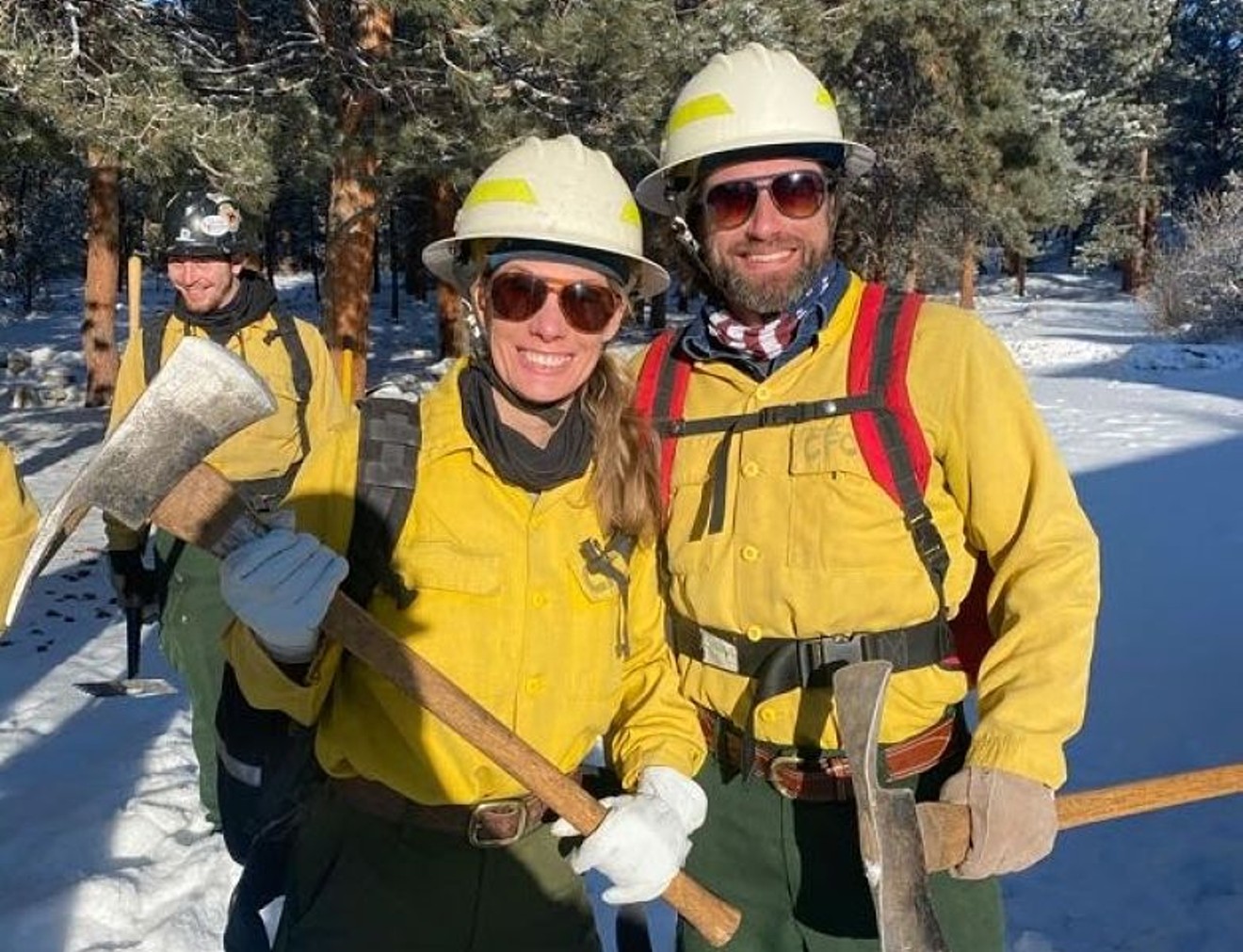On the second weekend in January, in the dead of winter, Zach Snavely and Corinne Hancock fought their first wildfire. The Littleton couple watched flames rising about twenty feet into the air, eating up snow-covered piles of fuel and radiating heat, as they and their teammates dug a preventative fireline into the dirt on the grounds near Salida’s Colorado Firecamp.
Just days before, Snavely, who served in the U.S. Coast Guard and has been working as an international military consultant, and Hancock, a leadership coach who has devoted much of her career to foreign aid projects, had no professional firefighting experience. But they were moved to change that after COVID-19 hit and several historic wildfires — including the Cameron Peak fire and East Troublesome fire near Rocky Mountain National Park, which collectively burned more than 350,000 acres — raged through the state in 2020.
“We were really looking for ways that we could help our community,” Hancock explains. “We both are in careers of being of service to our country and to the world, and we had no way to really engage in that. And seeing the fires last year was just devastating.”
Snavely and Hancock are far from the only people inspired to get into firefighting recently. Kent Maxwell, the founder of Colorado Firecamp, the only year-round wildland firefighting school in the country, says that enrollment has been heating up. The first quarter of the year is traditionally the lightest for training classes, but the camp has already seen about forty more students enroll in early 2021 than at the start of last year. Maxwell added two classes this month to accommodate the demand and the next four basic firefighter training classes are full, with waitlists building — “which is something we’ve seldom seen in the past,” he says.
“When you have a big fire year, it gets people excited about becoming wildland firefighters,” Maxwell adds. “The increase is because of last year’s fires, and people who are looking for a different way to make a living. Whatever they were doing either was not satisfying or not sustainable, based upon going in and out of COVID restrictions.”
The school usually trains anywhere from 750 to 900 students in a typical year, offering the same training available seasonally through some local fire departments, community colleges and state academies. That training equips both structure firefighters and individuals with no previous firefighting experience to work on a wildfire crew and join what Maxwell calls the “modern-day cowboy life,” adding that during the wildfire season, a firefighter may be called to a blaze across the state or even across the country. “You’re traveling the West. You’re up in these remote areas. You’re camping out under the stars.”
It's not for everyone, but the life suited Hancock and Snavely. “It’s great physical work, it’s great for that adrenaline rush and camaraderie and those things that I do miss from being in the military,” Snavely says. “And it’s just really showing that we don’t just talk about things; if we are passionate about something, we go for it.”
Many Colorado Firecamp graduates were on the front lines of the historic 2020 fires, from trainees who'd graduated a decade ago to a student who finished basic training in August, just four days before he was dispatched to fight several fires — including the Cameron Peak fire and fires in California.
To become qualified for a wildland firefighting position, individuals must take a basic course known nationally as S-130 and S-190 training; the course covers everything from weather patterns to fire behavior to how to dig a fireline. At Colorado Firecamp, the $475 class takes about four days and wraps with field training, when students fight prescribed burns and controlled fires under the supervision of experienced firefighters.
Those who complete the training then take what’s known as the pack test — a three-mile walk that a person must complete in 45 minutes or less while carrying a 45-pound pack. The test takes place after firefighters apply to an agency they would like to work for; if they pass, the agency can hire them and dispatch the new firefighters to active blazes.
Given climate change and the number of people moving into the foothills and close to forests, those new graduates will likely be very busy this year, too. “It does appear the trend is definitely toward more severe fires,” Maxwell says. But there are ways to slow that trend, he notes: “The homeowners really have control over what they can do in terms of their landscaping and making a defensible space. People need to keep doing more, in addition to having people that actually want to be firefighters.”
People like Hancock and Snavely, who says he’s already gotten in touch with the Buena Vista Fire Department, with plans to go through its recruitment process; if he’s hired, he’ll be fighting fires this season. Hancock, meanwhile, plans to continue with her responsibilities as a businesswoman and mother — but in a few years, she says she hopes to be fighting side by side with Snavely on the front lines of fires.
“Both of my parents were volunteer firefighters when I was young, and it made me really excited to carry on that tradition,” Hancock says. “We hope it provides motivation to our kids to be part of solutions to challenges that we face.”
[
{
"name": "Air - MediumRectangle - Inline Content - Mobile Display Size",
"component": "12017618",
"insertPoint": "2",
"requiredCountToDisplay": "2"
},{
"name": "Editor Picks",
"component": "17242653",
"insertPoint": "4",
"requiredCountToDisplay": "1"
},{
"name": "Inline Links",
"component": "18838239",
"insertPoint": "8th",
"startingPoint": 8,
"requiredCountToDisplay": "7",
"maxInsertions": 25
},{
"name": "Air - MediumRectangle - Combo - Inline Content",
"component": "17261320",
"insertPoint": "8th",
"startingPoint": 8,
"requiredCountToDisplay": "7",
"maxInsertions": 25
},{
"name": "Inline Links",
"component": "18838239",
"insertPoint": "8th",
"startingPoint": 12,
"requiredCountToDisplay": "11",
"maxInsertions": 25
},{
"name": "Air - Leaderboard Tower - Combo - Inline Content",
"component": "17261321",
"insertPoint": "8th",
"startingPoint": 12,
"requiredCountToDisplay": "11",
"maxInsertions": 25
}
]













